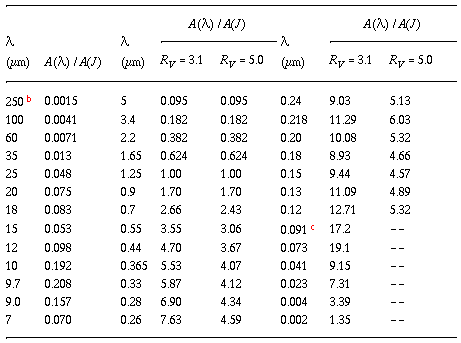Copyright © 1990 by Annual Reviews. All rights reserved
| Annu. Rev. Astron. Astrophys. 1990. 28:
37-70 Copyright © 1990 by Annual Reviews. All rights reserved |
2.3 Mean Extinction Laws
Table 1 is an estimate of the extinction law for
the observable range of
wavelengths, normalized to J ( 1.25 µm) because the extinction law is
assumed to be independent of environment for
1.25 µm) because the extinction law is
assumed to be independent of environment for  > 0.9 µm. The reader can
convert to A(
> 0.9 µm. The reader can
convert to A( ) /
A(V) by means of the tabulated A(V) / A(J). There are two
columns for
) /
A(V) by means of the tabulated A(V) / A(J). There are two
columns for  < 0.9
µm, representing the mean for diffuse dust (RV =
3.1) and outer-cloud dust (RV = 5), both calculated
from CCM89. The
difference between the two laws is striking. The 9.7- and
18-µm feature
profiles, as given by ``astronomical silicate''
(DL84),
have been added to a
power-law interpolation of an underlying continuum fitted between 250
and 7 µm. The profile of the silicate band was truncated at
25 µm, as is appropriate for circumstellar dust
(128),
but perhaps not for interstellar dust. The FIR opacity should be
extrapolated to longer wavelengths with a
< 0.9
µm, representing the mean for diffuse dust (RV =
3.1) and outer-cloud dust (RV = 5), both calculated
from CCM89. The
difference between the two laws is striking. The 9.7- and
18-µm feature
profiles, as given by ``astronomical silicate''
(DL84),
have been added to a
power-law interpolation of an underlying continuum fitted between 250
and 7 µm. The profile of the silicate band was truncated at
25 µm, as is appropriate for circumstellar dust
(128),
but perhaps not for interstellar dust. The FIR opacity should be
extrapolated to longer wavelengths with a  -2 dependence (see
Section 3.2.3);
the value in the table is determined by the estimate of Hildebrand
(70).
The ionizing-UV cross sections are from Martin and Rouleau
(107),
adjusted by a factor of 1.15 to make them continuous with the
extinction value of
CCM89
at 0.12 µm. Both the
``astronomical silicate'' and
ionizing-UV opacities are based upon the bare-silicate/graphite grain
model (see Section 8) and depend (through the
Kramers-Krönig
relations) upon the assumption that interstellar grains have densities
of ~ 3 gm cm-3.
-2 dependence (see
Section 3.2.3);
the value in the table is determined by the estimate of Hildebrand
(70).
The ionizing-UV cross sections are from Martin and Rouleau
(107),
adjusted by a factor of 1.15 to make them continuous with the
extinction value of
CCM89
at 0.12 µm. Both the
``astronomical silicate'' and
ionizing-UV opacities are based upon the bare-silicate/graphite grain
model (see Section 8) and depend (through the
Kramers-Krönig
relations) upon the assumption that interstellar grains have densities
of ~ 3 gm cm-3.

|
a A( ) / A(J) is the same for ) / A(J) is the same for
 > 0.9 µm for
all lines of sight, to within present errors. To estimate
A( > 0.9 µm for
all lines of sight, to within present errors. To estimate
A( ) / N(H),
multiply tabulated entry for RV = 3.1 by 1.51 x
10-22 cm2
(H atom)-1. Except as noted below, entries are calculated from
CCM89.
Other values of RV can be determined from
that paper. ) / N(H),
multiply tabulated entry for RV = 3.1 by 1.51 x
10-22 cm2
(H atom)-1. Except as noted below, entries are calculated from
CCM89.
Other values of RV can be determined from
that paper.
|
b For  > 250 µm,
multiply entry for 250 µm by (250 µm / > 250 µm,
multiply entry for 250 µm by (250 µm /  )2. )2.
|
c For  < 0.1 µm, entries
are from
(107),
increased by 1.15 for continuity with the
CCM89
extinction value at 0.12 µm. < 0.1 µm, entries
are from
(107),
increased by 1.15 for continuity with the
CCM89
extinction value at 0.12 µm.
|
The entries in the table for  > 15 µm are uncertain by at least a
factor of two. There are as yet very few
observational constraints upon the extinction law between the longer
wavelengths of the silicate feature (which probably varies from one line
of sight to another) and wavelengths
> 15 µm are uncertain by at least a
factor of two. There are as yet very few
observational constraints upon the extinction law between the longer
wavelengths of the silicate feature (which probably varies from one line
of sight to another) and wavelengths  > 100 µm, for which the energy
is produced by steady-state emission from large grains. The opacity at
> 100 µm, for which the energy
is produced by steady-state emission from large grains. The opacity at
 > 100 µm
is somewhat constrained by the emission from isolated clouds
warmed by the interstellar radiation field, which can be estimated.
> 100 µm
is somewhat constrained by the emission from isolated clouds
warmed by the interstellar radiation field, which can be estimated.